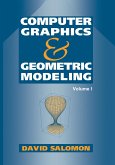A spline is a thin flexible strip composed of a material such as bamboo or steel that can be bent to pass through or near given points in the plane, or in 3-space in a smooth manner. Mechanical engineers and drafting specialists find such (physical) splines useful in designing and in drawing plans for a wide variety of objects, such as for hulls of boats or for the bodies of automobiles where smooth curves need to be specified. These days, physi cal splines are largely replaced by computer software that can compute the desired curves (with appropriate encouragment). The same mathematical ideas used for computing "spline" curves can be extended to allow us to compute "spline" surfaces. The application ofthese mathematical ideas is rather widespread. Spline functions are central to computer graphics disciplines. Spline curves and surfaces are used in computer graphics renderings for both real and imagi nary objects. Computer-aided-design (CAD) systems depend on algorithms for computing spline functions, and splines are used in numerical analysis and statistics. Thus the construction of movies and computer games trav els side-by-side with the art of automobile design, sail construction, and architecture; and statisticians and applied mathematicians use splines as everyday computational tools, often divorced from graphic images.
"Spline functions arise in a number of fields: statistics, computer graphics, programming, computer-aided design technology, numerical analysis, and other areas of applied mathematics. Much work has focused on approximating splines such as B-splines and Bezier splines. In contrast, this book emphasizes interpolating splines. Almost always, the cubic polynomial form is treated in depth. Interpolating Cubic Splines covers a wide variety of explicit approaches to designing splines for the interpolation of points in the plane by curves, and the interpolation of points in 3-space by surfaces. These splines include various estimated-tangent Hermite splines and double-tangent splines, as well as classical natural splines and geometrically-continuous splines such as beta-splines and n-splines. . . A variety of special topics are covered, including monotonic splines, optimal smoothing splines, basis representations, and exact energy-minimizing physical splines. An in-depth review of the differential geometry of curves and a broad range of exercises, with selected solutions, and complete computer programs for several forms of splines and smoothing splines, make this book useful for a broad audience: students, applied mathematicians, statisticians, engineers, and practicing programmers involved in software development in computer graphics, CAD, and various engineering applications."
--Zentralblatt Math
--Zentralblatt Math








